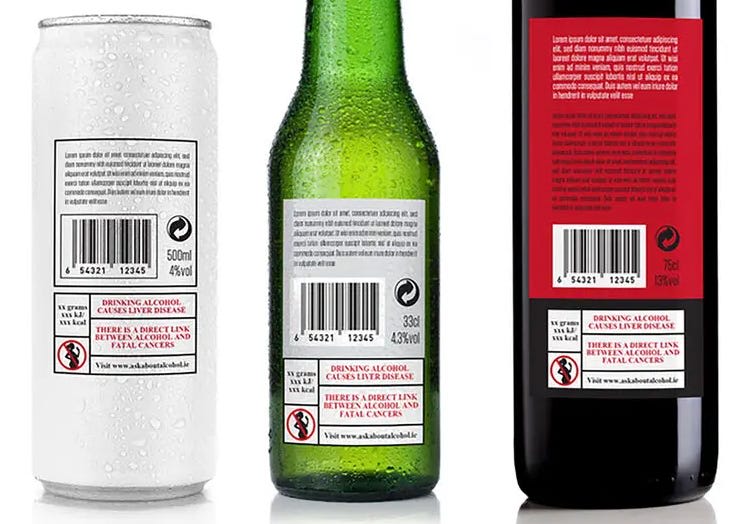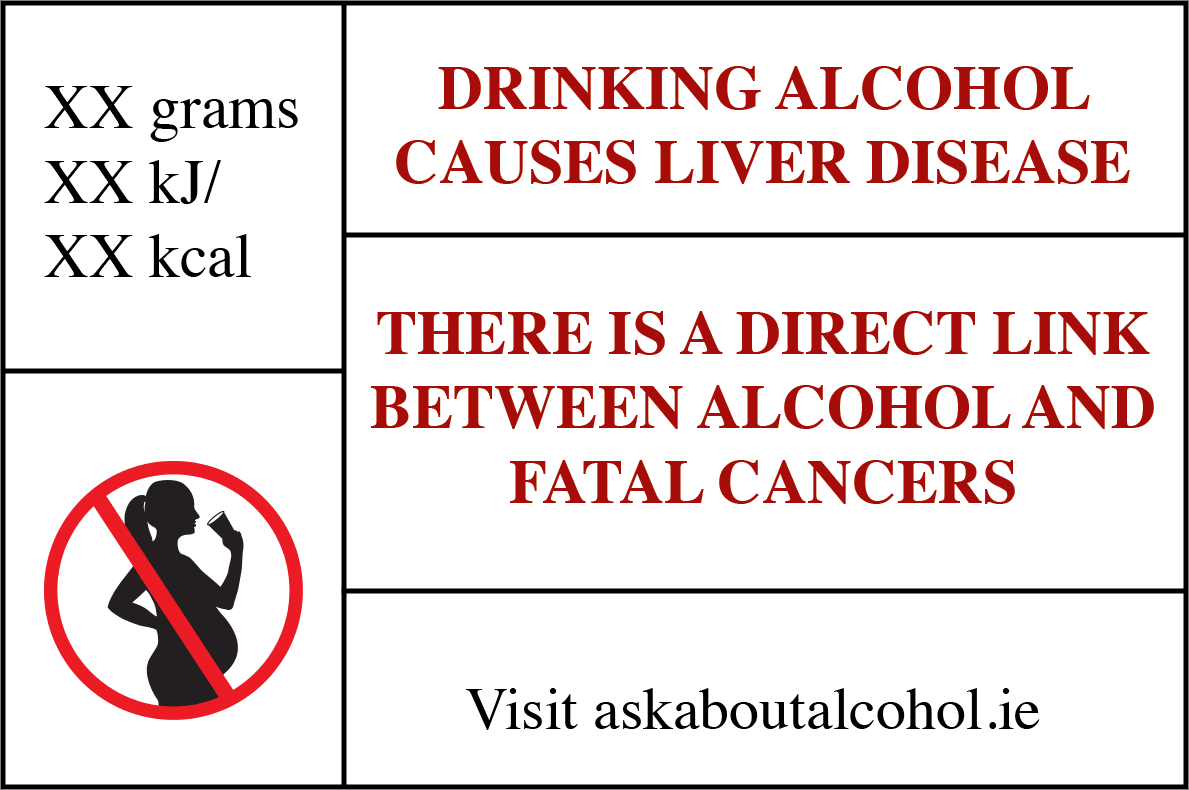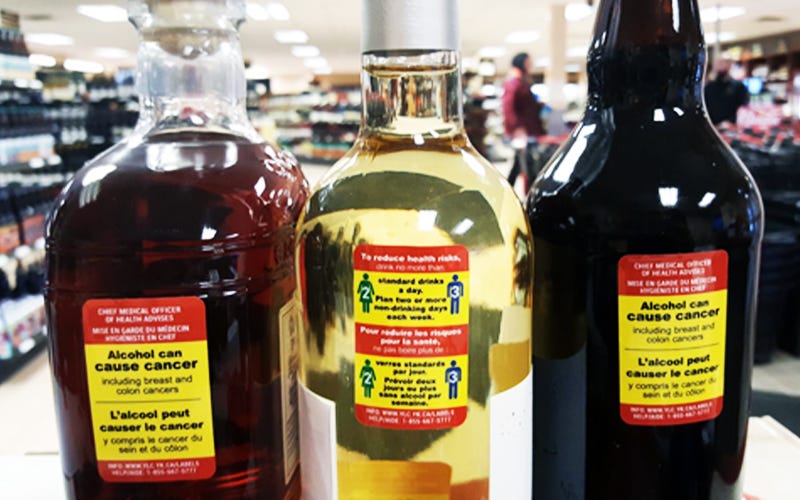Liquid discourage: Shoddy Goods 032
2
Regulatory policy! Meta-analyses! Cancer! Time for a super-fun Shoddy Goods, the newsletter from Meh about the stuff people make, buy, and sell. Belly up to the bar with me, Jason Toon, and let’s talk warning labels.
The march of medical research on alcohol is moving steadily in one direction: it causes cancer. Any kind of alcohol, in any amount, appears to raise your risk of seven different types of cancer, including breast, colon, liver, mouth, throat, esophageal, and stomach. Hey, I’m not thrilled about it either, but I gotta admit, it’s not looking good for ol’ CH3CH2OH.
Naturally this raises the question of whether society will, or should, start regulating alcohol like tobacco, the 20th century’s other favorite carcinogenic indulgence. So does that mean warning labels are coming soon to a bottle near you? I dug into the news to see what I could find out.

Here’s mud in your eye (and colon and liver and breast and esophagus and…)
How settled is the science?
I’m not a scientist, but all the global health heavy hitters are on the same side. The World Health Organization doesn’t mince words: “No level of alcohol consumption is safe for our health” and “Risks start from the first drop.” The Centers for Disease Control says “all drinks that contain alcohol… increase the risk of cancer.” Cancer Research UK agrees: “Drinking alcohol increases the risk of cancer.”
There’s no solace for the occasional tippler, either. In a Lancet article reviewing 10 other studies, WHO researchers found that “light to moderate alcohol consumption” (about two bottles of wine a week, or five beers) accounted for “2.3% of all cases of the seven alcohol-related cancer types” in Europe in 2017. And that’s just the light-to-moderate drinkers.
For those of you who reflexively write off anything the medical establishment says, I sincerely tried to find anyone seriously arguing “the other side” to this question, to no avail. (The alcohol industry lobby doesn’t count.) You’re welcome to “do your own research”, of course. As for me, I’m pretty convinced the establishment is onto something. Darn.
Are alcohol warning labels required anywhere now?
Forget those stale old “drunken Irish” jokes, because in 2023 Ireland became the first country in the world to require cancer warning labels on alcohol. Despite objections to the European Commission from EU wine industry groups that the law was an unfair barrier to trade, and other countries arguing to the World Trade Organization that the requirements would just be too darn complicated to follow, neither body took action to stop it. The land of Guinness and Jameson will see the first warning labels in 2026.

Uhh, actually, maybe I’ll stick with water… closeup of the label coming to Ireland.
South Korea passed a warning label system in 2016, but it allows manufacturers to choose from different labels, including some that don’t mention cancer. A 2017 study in Canada put cancer warning labels on bottles at the only liquor store in Whitehorse, Yukon - but outcry from the alcohol industry ended the study after just a few weeks. A labeling effort last year in Thailand came under similar fire.
Taking a different approach, California’s voter-approved Proposition 65 requires any store that sells alcohol to post signs that “alcoholic beverages may increase cancer risk.” A bill under consideration in Alaska would amend currently required warning signs in liquor stores to add “Alcohol can cause cancer, including breast and colon cancers.”
About a quarter of all countries have some kind of health warning label on alcohol products, particularly around driving and pregnancy (including the United States). But when it comes to cancer, that’s pretty much it.
Would warning labels reduce alcohol consumption?
At first glance, the record for cigarette labels seems mixed. Some studies show “knowledge of warning labels on cigarette packages and advertisements is not associated with reduced smoking.” Others call tobacco package warnings “a global success story”. What’s going on?
Turns out - duh - how the warnings are designed makes all the difference. The bigger, the more blunt the language, the more graphic the imagery, the better labels work to get people to reconsider using the product. But they’re also only part of a much wider cultural trend away smoking, which included both intentional strategic actions by health authorities and organic shifts among the population.
Those trends are already underway with alcohol. Americans under 35 are drinking, and overdrinking, less, as are young adults across Europe and Australia. And as we’ve covered in this space, nonalcoholic craft beverages are taking off. Some might say that organic decrease means warning labels are unnecessary. Others might say it means fertile ground for warnings to have even more impact.
We just don’t have that many directly relevant data points. In that Canadian study I mentioned earlier, sales of products with cancer warnings did indeed decrease, as did the overall sales of the store. That was only in one place, for a few weeks, so there would need to be more research to nail down the effects. But with an industry that fights research as hard as it fights the actual regulation, it seems more likely that the best data will come from jurisdictions that just go ahead and start regulating, like Ireland.

Yukon ho(ld the booze)! See the whole infographic here.
How comparable are tobacco and alcohol?
Aside from the fact that they both cause cancer, other differences between the two could be used to argue for different treatment. Cigarettes are addictive to pretty much 100% of regular smokers; there are very few “light to moderate” tobacco users, while most people who drink alcohol would fall into that category. Smoking affects other people’s health through secondhand smoke, while alcohol only (physically) hurts the people who drink it.
The biggest practical difference, barring some revelation that Big Booze has been sitting on explosive secret evidence, is that research into the alcohol-cancer connection is decades behind tobacco. And so likewise is public awareness: less than a third of US adults know alcohol causes cancer, with some 10% believing that wine actually decreases cancer risk. (That one doesn’t really appear to be true, by the way.) However, in California, with its Proposition 65 warning signs, 46% of adults are aware of the connection. So the message gets through, when it’s allowed to.
Are warning labels on the way?
That’s the big question. On the one hand, momentum is building in the public health community. Just this week, the WHO called for warning labels on alcohol. Last month, outgoing surgeon general Vivek Murthy did the same, joining entities as geographically diverse as the Cancer Council of Western Australia and the Norway Directorate of Health.
On the other, well, let’s just say the public appetite for health-based regulation at the moment is… uncertain. While President Donald Trump and new health secretary Robert F. Kennedy Jr. are both nondrinkers, and nominee Surgeon General Janette Neishewat has spoken approvingly of the drop in American alcohol use, labeling would require an act of Congress. Whatever their personal feelings, it seems unlikely that alcohol cancer warning labels would be a high enough priority for the Trump administration to push in a largely pro-business Congress, many of whose members have significant alcohol-related industries in their districts.

The experimental labels that sent the Canadian liquor industry into a tizzy.
Of course, a vocally determined public could change that - but as we’ve seen, awareness of the cancer-alcohol link remains low. Even in their best-case scenario, warning-label proponents are probably still years away from building the critical mass of public opinion that would push governments to take on the booze industry.
Personally, I don’t drink much these days anyway after my own tussle with cancer. But if we’re talking about rights, I’ll drink to the consumer’s right to know over any industry’s right to higher profits. Sure, life is full of risks; just don’t hide them from me. In any case, there will certainly be many more fights to come, and a lot of interest in whatever happens next. Ireland, get ready for your closeup.
I remember how shockingly blunt the cigarette labels were the first time I went to Europe. Of course, I also remember how prevalent smoking was, so it was hard to tell how well it was working. What do you think, are you affected by warning labels on products? Do you think other people are? Let’s talk in this week’s Shoddy Goods Chat!
—Dave (and the rest of Meh)
These past Shoddy Goods stories, while intoxicating in their own way, do not increase your cancer risk and are perfectly safe for women in all stages of pregnancy:
- 11 comments, 14 replies
- Comment
No.
@PhysAssist
and No.
@PhysAssist Yeah I don’t think the warning labels make much difference. It’s either something happening within their own circle of family/friends, or getting to a point where you realize Holy S#$t I’d rather stay alive.
@PhysAssist @pmarin
I think that there are a few people out there that are Manic and paranoid about it. I think most people have gone to the point where their jaded and ignore them. And there are some people who are in between
Oh well. I’m in my 60s–too late to stop now. I’ll take that 2.3% chance. (I’m sure that’s not how statistics work, but throw me a bone here.)
Tell that to the people whose friends and family members have been killed by drunk drivers.
@SSteve the actual numbers in the paper were that light to moderate drinking was responsible for 23000 cases of cancer in the EU in 2017. The EU saw 2.7 million new cases of cancer in 2022.
As a light to moderate drinker, your odds of getting cancer are higher than someone who doesn’t drink all else being equal: but it seems like your odds of getting cancer from drinking are pretty low. I’d have to read more, but considering your odds of getting cancer are 1 in 3 in your lifetime, and almost all of that is when youre 60 and older.
So if I get colon cancer at 72 and my doctor tells me it was because I spent my twenties drinking craft bees, a decade of having enjoyed my youth seems worth not living a couple more years of low quality elderhood.
Also cooked food causes cancer. What’s the risk of alcohol compared to not eating like a pre-Promethean cave man.
It depends on the true risk. Dinnerware with a California Prop.65 warning and that it may contain lead? No thanks, I’ll pass. Prop. 65 warning on something that I won’t be injesting or eating off of? Yeah, it’s fine to buy it.
@narfcake The really hard part with that is trying to guess at whether the warning is for anything actually in there that has any actual chance at getting to you, rather than the company not wanting to spend the money to prove that every component is guaranteed carcinogen-free.
I don’t think I’ve yet seen one of them say which chemical(s) in it the warning label is for. If it said lead? Yeah, I’d be paying attention to how I interact with it. If it said dihydrogen monoxide? I’d happily consider it safe enough to use/consume.
@narfcake @xobzoo You think DHMO is safe??? 100% of people who consume it die. It’s present in nuclear power plants. It only takes a small amount injected into the bloodstream for a quick, painful death. Know the risks. https://www.dhmo.org/truth/Dihydrogen-Monoxide.html
Excessive warning labels contain verbiage known by the state of California to cause desensitization and apathy.
It’s basically the classic story of the boy who cried wolf!
The warnings that are useful are the portion of food labels that say it contains peanuts, or dairy, or wheat, or shellfish, or anything else that some people need to know about before they eat it. Those are helpful, and I’m glad they exist.
(But I’m pretty sure that’s not what this topic was intended to be about.)
To answer the original question: I doubt warning labels (like on cigarettes) actually deters anyone. (or, at least, not any meaningful percentage of people).
I imagine that those who are most likely to be swayed by a warning like that have probably already researched the topic elsewhere.
/8ball Do warning labels on cigarettes do anything?
 Don’t count on it
Don’t count on it
Leisure suits cause cancer in rats
@aetris Laboratories cause cancer in rats.
Warning labels won’t change anything. Just like warning labels hasn’t changed people that currently smoke.
@ironcheftoni Mmm. It’s called “tumors” now, but I still can’t stop smoking them!
I rarely drink… I understand when I do it may cause cancer. Warning labels won’t consciously make me drink less (hard to drink much less than I do without completely quitting- it’s like one drink a month on average). Who knows it may make me drink less subconsciously… or maybe it won’t.
@OnionSoup Living on the edge: Yesterday my wife and I went out for lunch. I had a sandwich made with smoked pulled pork and BBQ sauce, washed down with a PNW IPA. I wonder which component of the meal was the biggest health risk?
@macromeh - Probably the sugar
I remember reading a study showing that both smokers and non-smokers alike vastly overestimated how dangerous smoking actually was. Obviously, different folks make different risk/benefit analyses. I don’t smoke or drink because the the downsides I experience (which is different than the harms I MIGHT experience) outweigh the benefits I experience. YMMV. Drugs have side effects. All drugs. Warning labels are a poor substitute for education.
@jozseph also remember that tobacco companies advertised and had actors portraying doctors that cigarettes were healthy. In my small town growing up. There were 6 doctors and I think all but 2 smoked.
In my small town growing up. There were 6 doctors and I think all but 2 smoked.
In my 20s, I had horrible acne. My doctor, instead of prescribing medication, suggested going to a tanning booth. This was 40 years ago. It did help clear up the acne and I’ve been lucky that I haven’t had skin cancer thus far. And I don’t go to tanning booths anymore.
@jozseph grabbing the attention span of the average consumer has forever been an uphill battle - much like political messages and advertisements, the time and effort to have a message sink in and cause empathy/sympathy have taken a backseat to quick hot takes.
This was a sobering read!
I’d like to see the distribution of percentages of incidence of the subject cancers across all categories of alcohol consumer including the non-consumer before I’d accept their assertion that the risk is significant.